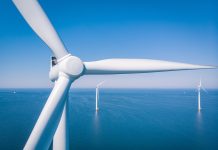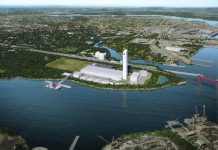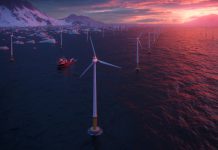Even with all the nuts and bolts and other physical properties that make up a wind farm and its assets, there still is much more behind-the-scenes involvement with getting a massive renewable-energy project to the point where it is creating power.
Consultancy services can be as vital as the actual materials that make up a wind farm, whether that farm is in the middle of Texas or jutting up out of the Atlantic.
That’s where the expertise and experience of K2 Management (K2M) comes in.
“K2M, as a whole, provides a wide range of consultancy services involving engineering, planning, project management, and due diligence all across the entire value chain of mainly wind, but also solar projects,” said Dr. Joel Manning, manager and R&D lead — Analysis Services with K2M. “We support clients from early development all the way through construction management and maximizing the efficiency of projects through asset management. The whole range of consultancy services are within K2M, but my particular area is in analysis services.”

Data-led Technical Advice
K2M’s analysis services provide data-led technical advice, according to Manning, and its core service is pre-construction energy-yield assessment as well as operational services.
“As a department within K2M, we also provide pre-construction and operational services to both onshore and offshore wind, as well as solar projects,” he said. “But that core product of pre-construction energy yield assessment is a major focus of our expertise.”
For K2M’s analysis services team, the ideal workflow would be to first engage clients at the very early stages of development when selecting an optimal site for a project, according to Manning.
“We might do some early analysis based on high level data, or it might be a preliminary energy yield assessment that can be done very quickly. But it allows informed site selection, and then we’ll help them to design the best possible measurement campaign, which will measure the wind conditions and atmospheric conditions at the site and will eventually lead to the best, most accurate, lowest uncertainty energy yield assessment,” he said.
K2M also offers what Manning calls its Meteor platform, which helps manage that wind or solar measurement data for its clients.
“As more data is measured, we can provide further energy-yield assessments with ever increasing, data-led confidence, providing a soft landing all the way to the financial decision-making time,” he said. “This is when we’re really applying all of our best modeling and statistical methods to produce the lowest possible uncertainty and most accurate energy yield assessment to help value the project, minimizing the client’s cost of capital when it comes to financing, and eventually building the project.”
As the project progresses, K2M will also optimize the layout to help maximize the energy yield, according to Manning.
“With the energy yield assessment product, we’re providing an accurate P50 prediction — a prediction where we think there’s a 50/50 chance of it being above or below with the lowest possible uncertainty,” he said. “Over time, we can demonstrate how accurate we are, which builds trust in our methods. The lowest possible uncertainty equates to the highest possible confidence for investors and lenders. It also equates to the best financial terms and the lowest cost of capital for the developer.”
Offshore Energy Report
To that end, K2M recently released its comprehensive report, “Offshore Energy Yield Predictions — Validation Report 2023,” the world’s largest independent offshore energy yield validation study to date, according to Manning. The report emphasizes the importance of precise energy yield prediction and validation, citing concerns around the trend of applying overly general methodologies to offshore wind and inflating energy yield projections to secure short-term investor confidence.
“This study is something we’re really proud of,” he said. “It’s the world’s largest study of its kind. It has more data in this validation from more projects than any other offshore validation to date. The reason that’s important is the more data you put into a validation, the more applicable and the more confident you can be in the conclusions. It being the world’s largest means we’re very confident in the conclusions. It also shows very close agreement between our predictions and what the projects finally produce. The key point for the sector as a whole is that, whilst there are currently many significant uncertainties around the development of offshore wind, prediction of energy yield isn’t one of them.”

The report conclusively proves that energy yield can be predicted to a high degree of precision, which provides confidence in that area of development, according to Manning.
“For K2M, being able to demonstrate our offshore energy yield prediction accuracy is very valuable,” he said. “‘Bankability’ is a big term in the energy yield assessment community, to describe whether a study can be trusted by a financial institution. However, it’s a very slippery term as there’s no formal definition of bankability. We feel this type of validation study is as close as you can get to a certificate of bankability.”
The data from the report comes from 42 operating offshore projects, equating to about 14 GW of installed capacity spread across the whole of northern Europe, according to Manning. “We show how, across all the areas where there are currently big operating offshore wind farms, energy yield prediction can be accurate in a way that directly relates to the financial decision-making,” he said. “This is a key conclusion for the industry.”
Using the Report to Address the Future
One of the primary goals of the report is being able to use the results to extrapolate to future projects, according to Manning.
“Whilst validation is really the only way of proving the accuracy of future predictions, the big challenge is that you can only use operational data from projects that have already been built and are operating,” he said. “This is a challenge as validation is always a little behind the technology that’s going to be applied for future projects. Currently, the offshore wind industry is still experiencing big growth in the size of turbines, the size of projects, and the density of projects, as well as expanding into other geographies. It’s always a challenge to prove that a validated method can be applied outside the envelope of the currently available data.
We’re always looking to expand that validation envelope by applying more data that’s been produced by the latest technology or from a wider geographical area. We are very confident about extrapolating outside of this envelope, because we include so many physical drivers of energy yield in the modeling and statistical methods that we use to produce these predictions.”
And what has made the report a success in the eyes of K2M is that it has served to validate what the company has been doing for years, according to Manning. “It has reinforced what we’re doing; we are now even more confident in our approach,” he said. “The fundamentals of our method have not changed since the previous iteration of the validation, which we produced in 2017. In that time, the industry has seen quite a few issues, which have impacted energy yield prediction methods. I think probably most famously Orsted devalued their development portfolio some years ago due to the impact of the blockage effect, which was not commonly included in energy yield assessment prior to that. However, our methods, because they’re based on this end-to-end validation approach, were already accurate prior to that point.”
Validating K2M’s Methods
Manning emphasized that, despite changes to the industry in the last six years, the validation has shown that K2M’s methods are reliably accurate.
“And now, producing this recent report, which contains a larger volume of data, gives us further confidence that we really are doing something that can be applied as wind-energy technology evolves,” he said. “However, we don’t take that for granted. We continually keep our eye on the technological developments and the fact that turbines and projects are still growing. We are constantly checking that there will not be any surprises in the future and looking for new ways to further reduce energy yield uncertainty.” The recent report has only served to give K2M more confidence in dealing with its clients and addressing any challenges they may have with their projects, according to Manning.
“We always like to see good consultancy as starting with good communication,” he said. “When a client comes to us, we need to understand the challenge that they are bringing and see what stage of development they’re at so we can provide them with the best value service that is most appropriate for their situation. But for us in analysis services, that will always be looking toward financial close and bankability. The validation report provides us, and our clients, with a very high level of confidence that we will produce the best possible accuracy at financial close, and we will help the client to reach that stage as efficiently as possible.”

Global Expertise
K2M has worked on hundreds of projects across all the major continents for years, according to Manning, as well as contributing to a large number of projects in all the major offshore markets to date.
The company supported the development of the Deutsche Bucht Wind Farm in the Southern Baltic. It has also been involved in different aspects of the development of the Dogger Bank Wind Farm, which will be the world’s largest wind farm when completed. K2M is also supporting as project manager for Pacifico in South Korea; as lender’s technical adviser for Hai Long, and as owner’s engineer on BlueFloat, both in Taiwan; and in the U.S., as owner’s engineer US Wind in Maryland, and owner’s QA representative for Dominion Energy on Coastal Virginia Offshore Wind.
With its vast history with renewable energy, it’s safe to say K2M will continue to have a hand in many more projects as net-carbon demands continue to grow across the globe, even with some recent challenges that have cropped up within the offshore sector, according to Manning.
“Looking back 10 years, a lot has changed; things were very different from what they are now,” he said. “The last few years have been challenging for the wind industry in general, and particularly for offshore wind. It’s no secret that the European OEMs have been struggling with profitability, and there have been a number of high-profile issues with large projects, particularly in the U.S. recently, as well as the auctions in the U.K.
But I think, despite that, we’re seeing that readjustment is coming to an end, and growth is starting to be back in the cards. Offshore wind continues to be a core focus and one of the largest growth areas for K2M.”
That growth is, ultimately, inevitable as long as governments continue to push their green initiatives, and Manning said K2M is in a good position to help their clients to make those projects a reality.
“K2M is extremely well-placed to support this growth,” he said. “We are able help the industry to grow efficiently and to make sure each project progresses with as little friction as possible. The offshore study that we’ve just done is one illustration of how K2M is at the forefront of technical knowledge and is able to provide practical benefits that maximize efficiency for our clients. That is one thing I don’t see changing.”
More info: www.k2management.com.
For the report, go to info.k2management.com/offshore-energy-yield-predictions-a-validation-guide.



























